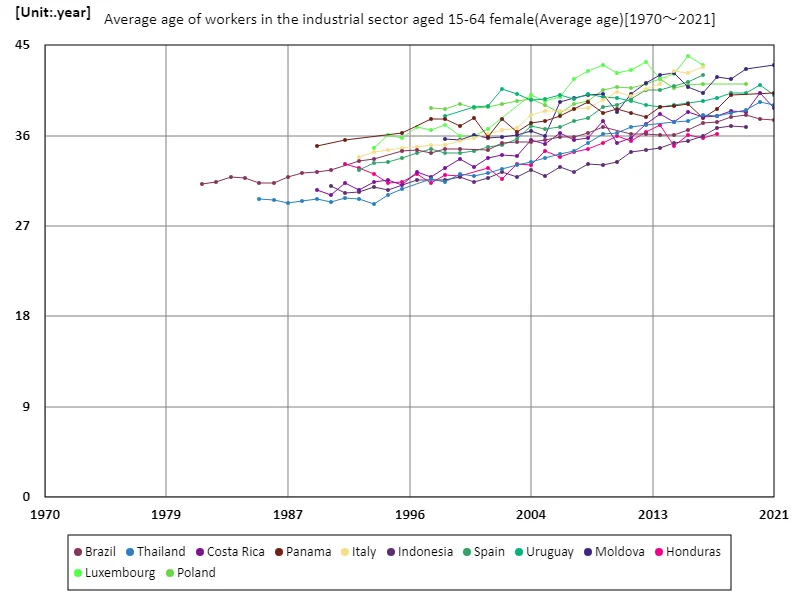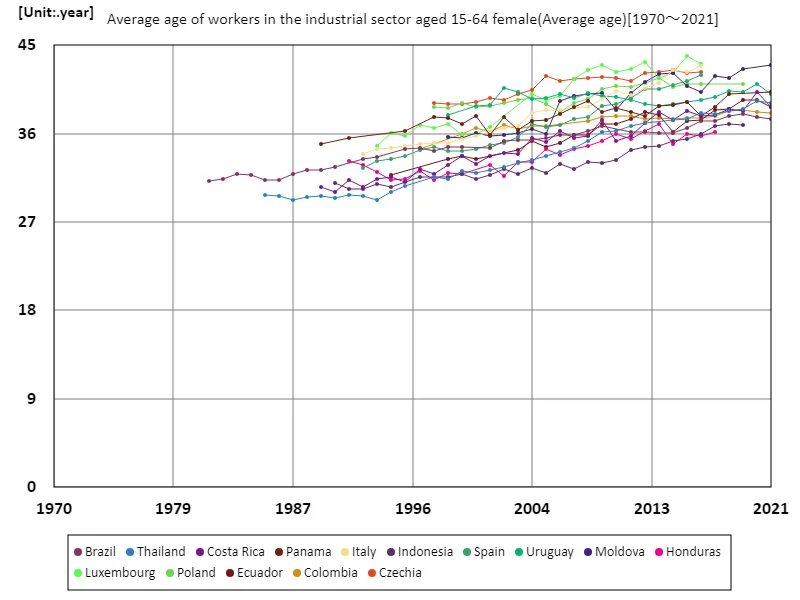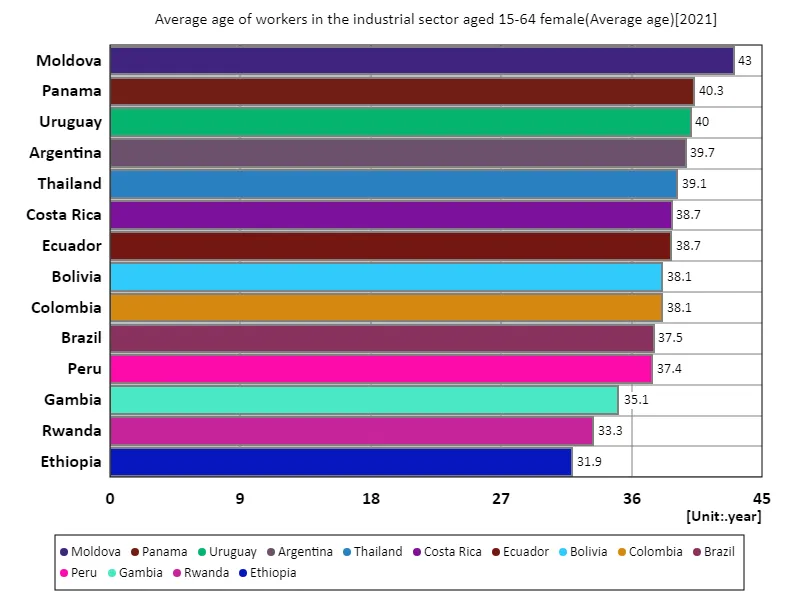- Abstract
- Industrial sector, female workers aged 15-64, average age
- Industrial sector, female workers aged 15-64, average age (worldwide)
- Industrial sector, female workers aged 15-64, average age (world, latest year)
- Industrial sector, female workers aged 15-64, average age (region, latest year)
- Reference
Abstract
The median age of female workers aged 15-64 in Moldova’s industrial sector was 43 in 2021, the highest figure ever recorded, suggesting some interesting trends in the labour market. First, an ageing workforce may reflect structural issues in labor supply or a lack of young people entering the labor market. Moreover, the persistent ageing of the economy’s industrial sector is likely to affect firms’ productivity and innovative capacity. The historical trend, particularly in Eastern Europe and the former Soviet Union, is that the workforce is ageing, driven by a combination of factors including social and economic changes. The Moldova case highlights challenges to the health and future sustainability of the industrial sector’s labour market, and it is important to analyse these factors in more depth.
Industrial sector, female workers aged 15-64, average age
Based on data from 1981 to 2021, the average age of female workers aged 15-64 in the industrial sector has shown a trend of increasing over time. In particular, Luxembourg recorded a peak of 43.9 years in 2015, but has since fallen to a level of 98%. This trend reflects changes in the labor market, shifts in the economic structure, and demographic forces. The average age of female workers in the industrial sector has risen over the past few decades due to an ageing workforce and a lack of young people entering the workforce. In many developed countries, structural changes in industry and technological advances have led to a shift from the industrial sector to the service sector, resulting in an aging workforce. In countries with a significant ageing population like Luxembourg, there is a need to develop young people and improve working conditions in order to cope with changes in the labour market. A comparison of Luxembourg’s current situation with its peak also reveals the impact of labor market trends and economic policies. Efficient utilization of the aging workforce and development of a new workforce will be important issues for the sustainability of the economy in the future.


The maximum is 43.9year[2015] of Luxembourg, and the current value is about 98%
Industrial sector, female workers aged 15-64, average age (worldwide)
Between 1981 and 2021, the average age of female workers aged 15-64 in the industrial sector has increased significantly. In particular, Luxembourg recorded a peak of 43.9 years in 2015, but has now fallen to 98% of that peak level. This trend reflects several important economic and social factors. First, the ageing of the industrial sector signals structural and demographic changes in the labour market. The average age is rising as the ageing workforce grows while younger people enter the workforce less. In particular, the composition of the industrial workforce is changing as the economy shifts towards the service and technology sectors, resulting in an increase in the average age of female workers in the industrial sector. In the case of Luxembourg, the average age has fallen slightly since the peak of ageing in 2015 to the present due to changes in the labour market and economic policies. This may be due to the effectiveness of revitalizing the labor market and encouraging young people to enter the workforce. However, with the population still ageing, further policy responses are needed to ensure the sustainability of the labour market. The data makes it clear that workforce changes in the industrial sector are influenced by economic structures and policies, calling for strategic responses to the future of the labor market.


The maximum is 43.9year[2015] of Luxembourg, and the current value is about 98%
Industrial sector, female workers aged 15-64, average age (world, latest year)
According to 2021 data, the average age of female workers aged 15-64 in the industrial sector is 37.9 years, with Moldova recording the highest average age at 43 years. The data shows a notable trend of ageing of the labour market in the industrial sector. Moldova’s high average age reflects structural changes in the labour market and socio-economic factors. In particular, the ageing of the industrial sector is thought to be due to problems in the labor supply and a lack of young people entering the labor market. As the economy develops and technological innovation advances, there is a growing trend for younger people to shift to service and technical jobs, while older people tend to remain in the industrial sector. Additionally, the overall average age is 37.9 years, indicating that in many countries female workers in the industrial sector are at a relatively high age. This speaks to an ageing industrial sector and a lack of young people entering the labour market overall. In order to efficiently utilize the aging workforce, it is important to create an appropriate working environment and develop younger workers. These trends call for policy responses in response to labour market developments and strategies aimed at the sustainable development of the industrial sector.


The maximum is 43year of Moldova, the average is 37.9year, and the total is 531year
Industrial sector, female workers aged 15-64, average age (region, latest year)
According to 2008 data, the average age of female workers aged 15-64 in the industrial sector was 29.8 years, with the Central African Republic having the highest age. The overall average age is 29.8 years, indicating that the age group of female workers in the industrial sector is relatively young. This trend is particularly prevalent in the industrial sector in developing countries. In countries like the Central African Republic, labour markets are often still dependent on young people, which reflects the fact that their economies are less developed and industrialised than the rest of the region. Reasons for the large youth workforce include the underdevelopment of educational institutions and limited economic opportunities that lead young people to enter the labor market early. Additionally, the industrial sector’s reliance on a relatively young workforce may vary with labour market dynamics and the maturity of the economy. Developing countries often still have a predominantly young workforce compared to developed countries, where the population is ageing amid rapid economic growth and industrial development. The data contributes to a better understanding of the age structure of the workforce in the industrial sector and is an important indicator when considering labour market trends and the stage of economic development.


The maximum is 29.8year of Central African Republic, the average is 29.8year, and the total is 29.8year



Comments